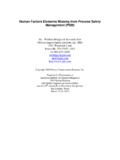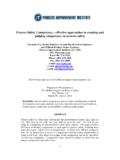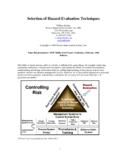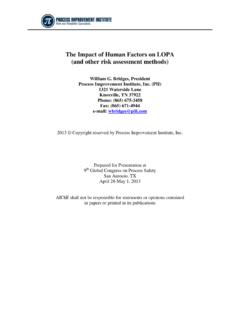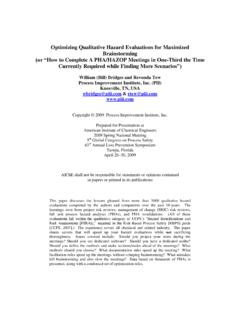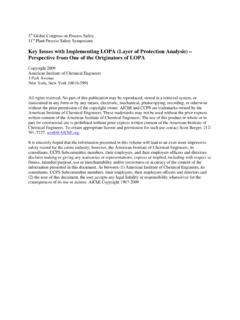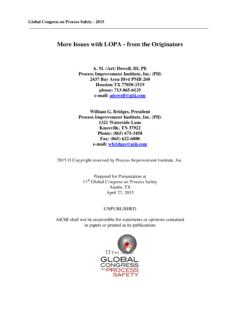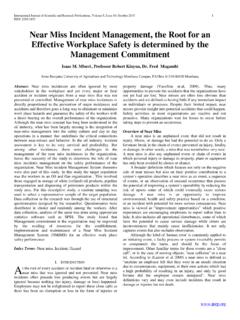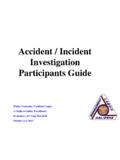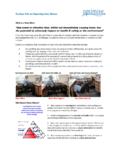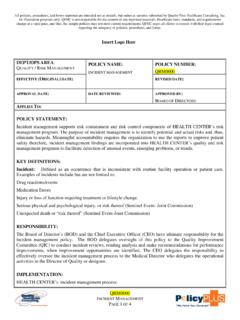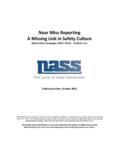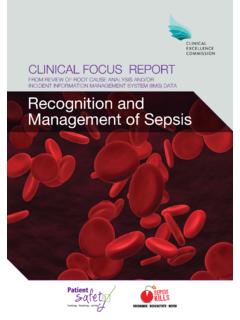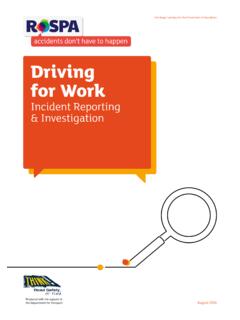Transcription of Gains from Getting Near Misses Reported
1 _____ 1 Gains from Getting Near Misses Reported Mr. William G. Bridges, President Process Improvement Institute, Inc. (PII) 1321 Waterside Lane Knoxville, TN 37922 Phone: (865) 675-3458 Fax: (865) 622-6800 e-mail: 2012 Copyright reserved by Process Improvement Institute, Inc. Prepared for Presentation at 8th Global Congress on Process Safety Houston, TX April 1-4, 2012 Keywords: investigation, near miss, accident, incident, root cause, RCA ABSTRACT The need for effective root cause analysis is finally gaining the spotlight in the chemical process industry. If we do not find out about an incident, we cannot investigate the root causes. We find out about accidents (harm done) because they are difficult to hide. However, there is only one accident for about 10,000 errors and failures (sometimes called unsafe acts and unsafe conditions).
2 The definition of a near miss (a potentially damaging sequence of events and conditions, but without harm) can be vague and varies from site to site. However, data indicates that there are probably about 100 near Misses for every accident. Learning from near Misses is much, much cheaper than learning from accidents, yet many companies get less than one near miss Reported for each accident. This paper describes the reasons why near Misses are not Reported and shares how companies have increased the reporting ratio to as high as 105:1; it is an update of the basis for Chapter 5 of Guidelines for Investigating Chemical Process Incidents, Second Edition (CCPS, 2003). 2 Introduction We must learn from accidents and near Misses to prevent recurrence. The first step in the learning process is investigation to determine the causes and underlying reasons why accidents and near Misses occur.
3 A thorough investigation of root causes will identify the management system weaknesses. Learning which management system weaknesses are leading to near Misses and accidents is one of the highest value activities in which a company can invest, and learning from near Misses is much cheaper than learning from accidents. Many chemical companies have implemented process safety management systems, and now they are beginning to focus on Getting near Misses Reported and on root cause analysis. This is a very exciting trend. Unfortunately, the chemical industry gets very few near Misses Reported (the chemical industry is certainly not the only industry with this problem). To understand more about near Misses and Getting them Reported , it is best to first review the basic definitions. An incident is either an accident or a near miss.
4 An accident is a sequence of unplanned events and conditions that result in harm to people, environment, process, product or image. A near miss is an unplanned sequence of events that could have caused harm if conditions were different or is allowed to progress, but did not in this instance. Using just these basic definitions, it is very difficult to make a consistent determination on whether a specific event is a near miss or a "non-incident" (neither an accident nor a near miss). If the users of the investigation system do not identify an event to be at least a near miss, then the event will not be investigated and valuable lessons will be lost. This aspect of near miss reporting will be discussed later. We also need to define causal factor and root cause; the definitions below are used later in this article: A causal factor is a human error (typically an error by the at-risk employee performing a task/job in the process) or a component fault/failure.
5 Note that these human errors and component failures are probably caused by other humans making mistakes, and all errors are controlled by management systems. An incident typically has multiple causal factors. Natural phenomena can also be a causal factor. A root cause is a management system weakness that results in a causal factor. A casual factor typically has multiple root causes. The definitions above are the same as used in Guidelines for Investigating Chemical Process Incidents, Second Edition (CCPS, 2003). Given a consistent understanding of the definition of a near miss, it is possible to estimate how many near Misses should be Reported for every accident. Studies in several industries indicate that there are between 50 and 100 near Misses for every accident. Also, data indicates that there are perhaps 100 erroneous acts or conditions for every near miss.
6 This gives 3 a total population of roughly 10,000 errors for every accident. Figure 1 illustrates the relationships between accidents, near Misses and non-incidents. Figure 1: Relationship between Errors and Potential or Actual Impacts Another way to think about near Misses in the chemical industry is that there is about one near miss per plant worker per week. The ratios cited depend heavily on the definition of a near miss and also depend on the type of loss. However, across industries there are roughly equivalent ratios of accidents and near Misses and errors: Example: Toyota reports there is a ratio of 20,000 errors per major economic loss event. Toyota also requires reporting of about 70 issues per worker per year (these issues can include process improvement ideas of near Misses ) (Moore, 2007).
7 Assuming the majority of the issues are near Misses to at least a minor loss, this is roughly one near miss per worker per week. Example: In passenger air travel, the pilots make about one mistake per two hundred steps (per review of Black Box data randomly selected by two airlines); or one (or several) mistake per flight. As of 2010, there were about 100,000 scheduled flights per day (approximately 35 million flights per year) and an average of crashes per million flights (major losses). This is an average of about 1 million errors per major accident. Overall, there are roughly 10,000 errors per loss event (aircraft damage or injury), not counting damage from natural phenomena, such as bird strikes (which are about 100,000 strikes per year). Although a formal tally is not available, there appears to be roughly 100 near Misses per minor or major loss event.
8 Example: One ALCOA site (internal data) had a ratio of about 80 near Misses per loss event, and that site required each plant worker to report a minimum of four near Misses per month (about one per week). 4 So, across very different industries there appears to be roughly the same ratio of errors to major events and the same ratio of errors and near Misses to total loss events (major and minor). Unfortunately, as mentioned earlier, many companies in the chemical industry only get a small fraction of near Misses Reported . In fact, most of the more than 400 chemical companies we deal with indicate that they get only about one or two near Misses Reported for every accident. And though some companies achieve a ratio of 20 or higher, many others get fewer near Misses Reported than accidents (ratio less than one).
9 Importance of reporting and learning from near Misses Investigating near Misses is critical to preventing accidents, because near Misses share the causes and root causes of accidents; they are one or two barriers away from the loss/accident. We are very likely preventing many apparently unrelated accidents when we prevent the ones that are obviously related. Figure 2 illustrates a hypothetical relationship between causal factors and root causes of accidents and those for near Misses . From our experience, this relationship appears to be valid; see the case studies and benefits section of this paper to see some of the proofs of this concept. Figure 2: Interrelationship between the causes of Accidents (Losses) and the causes of Near Misses As a brief explanation of Figure 2, root causes (management system weaknesses) make it more likely for a causal factor to occur and combinations of causal factors (or in rare cases, perhaps a single 5 causal factor) result in near Misses and additional causal factors result in losses (accidents) in increasing severity.
10 Also, a root cause can increase the likelihood of seemingly unrelated causal factors. Example: A systemic issue with written operating procedures, such as not leaving a blank line between steps, can lead to higher probability of an operator losing their place in the procedure. This deficiency can be repeated across all procedures at the site (operating and maintenance procedures). So, correcting this deficiency in one unit s procedure will help; but correcting the format rules for the entire facility will help reduce the chances of any worker losing their place in a procedure. Example: A systemic issue with PHAs across a company, such as not performing a hazard analysis of non-routine modes of operation, can lead to missing up to 90% of the accidents that occur during non-routine modes; and 80% of major process safety incidents occur during non-routine modes of operation.
